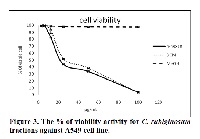Antioxidant and Cytotoxic Activities of Calophyllum rubiginosum
Keywords:
Calophyllum rubiginosum, Antioxidant, DPPH, Reducing power, Chelating iron ions, CytotoxicityAbstract
Clusiaceae / Guttiferae an evergreen shrubs or trees, it is considered as a family of 27 genera and 1090 species. Calophyllum rubiginosum one of these species and belongs to this family. In Malaysia they use it as folk remedies, where they believe its’ activity. Problem: Evaluation of antioxidant and cytotoxic activities of three fractions. n-hexane, dichloromethane (DCM) and methanol (MeOH) of Calophyllum rubiginosum species. Approach: The three main fractions were tested to find out the antioxidant capacity using three different methods, DPPH radical scavenging, reducing power and chelating iron ions. The fractions were tested against lung cancer A-549 cell line to assess the anti-proliferation activity. Results: The MeOH fraction showed no effect against lung cancer cell line but achieved a significant result in antioxidant testing. The DCM and n-hexane fractions considered as moderate antioxidant agent, they showed a significant result against lung cancer cell line. Non and semi polar fractions were able to inhibit the proliferation of A-549 cell line at low concentration. The results were statistically significant (P< 0.05). Conclusions: C. rubiginosum fractions have showed significant activity. DCM and n-hexane fractions proved to be effective against A-549 lung cancer cell line, where they were able to disturb the cell proliferation. These results can benefit the local community, and to guide how to use this plant.
References
Amarowicz R, Pegg RB, RahimiMoghaddam P, Barl B, Weil JA. Freeradical scavenging capacity and
antioxidant activity of selected plant
species from the Canadian prairies. Food
Chemistry. 2004;84(4):551-562.
Kim M-B; Park J-S; Lim S-B,
Antioxidant activity and cell toxicity of
pressurised liquid extracts from 20
selected plant species in Jeju, Korea. Food
Chemistry. 2010;122(3):546-552.
Prasad KN; Xie H; Hao J; Yang B; Qiu S;
Wei X; Chen F; Jiang Y. Antioxidant and
anticancer activities of 8-hydroxypsoralen
isolated from wampee [Clausena lansium
(Lour.) Skeels] peel. Food Chemistry.
;118(1):62-66.
Lee J-Y; Hwang W-I; Lim S-T,
Antioxidant and anticancer activities of
organic extracts from Platycodon
grandiflorum A. De Candolle roots.
Journal of Ethnopharmacology.
;93(2-3):409-415.
Siddhuraju P; Mohan PS; Becker K,
Studies on the antioxidant activity of
Indian Laburnum (Cassia fistula L.): a
preliminary assessment of crude extracts
from stem bark, leaves, flowers and fruit
pulp. Food Chemistry. 2002;79:61-67.
Ho S-T; Tung Y-T; Cheng K-C; Wu J-H.
Screening, determination and
quantification of major antioxidants from
Balanophora laxiflora flowers. Food
Chemistry. 2010;122(3):584-588.
Su X-Y; Wang Z-Y; Liu J-R. In vitro and
in vivo antioxidant activity of Pinus
koraiensis seed extract containing
phenolic compounds. Food Chemistry.
;117(4):681-686.
Russo A; Cardile V; Lombardo L;
Vanella L; Vanella A; Garbarino JA,
Antioxidant activity and antiproliferative
action of methanolic extract of Geum
quellyon Sweet roots in human tumor cell
lines. Journal of Ethnopharmacology.
;100(3):323-332.
Kamuhabwa A, Nshimo C, Witte P.
Cytotoxicity of some medicinal plant
extracts used in Tanzanian traditional
medicine. Journal of Ethnopharmacology.
;70(2):143-149.
Pretto JB, Cechinel-Filho V, Noldin V. n.
F, Sartori M R K, Isaias D E B, Cruz A B.
Antimicrobial Activity of Fractions and
Compounds from Calophyllum
brasiliense. Z. Naturforsch. 2004;59:657-
Taher M, Idris MS, Ahmad F, Arbain D.
A polyisoprenylated ketone from
Calophyllum enervosum. Phytochemistry.
;66(6):723-726.
Cottiglia F; Dhanapal B; Sticher O;
Heilmann, a. J. r., New Chromanone
Acids with Antibacterial Activity from
Calophyllum brasiliense. J. Nat. Prod.
;67:537-541.
Zou J; Jin D; Chen W; Wang J; Liu Q;
Zhu X; Zhao, a. W., Selective
Cyclooxygenase-2 Inhibitors from
Calophyllum membranaceum. J. Nat.
Prod. 2005;68:1514-1518.
Li Y.-Z; Li Z-L; Yin S-L; Shi G; Liu MS; Jing Y-K; Hua H-M, Triterpenoids
from Calophyllum inophyllum and their
growth inhibitory effects on human
leukemia HL-60 cells. J.Fitoterapia. 2010.
Guilet D; raphin DS; Rondeau D;
Richomme P; Brunetona J, Cytotoxic
coumarins from Calophyllum dispar.
Phytochemistry. 2001;58:571-575.
Hinneburg I; Damien Dorman HJ;
Hiltunen R. Antioxidant activities of
extracts from selected culinary herbs and
spices. Food Chemistry. 2006;97(1):122-
Maiga A; Malterud KE; Diallo D; Paulsen
BS. Antioxidant and 15-lipoxygenase
inhibitory activities of the Malian
medicinal plants Diospyros abyssinica
(Hiern) F. White (Ebenaceae),Lannea
velutina A. Rich (Anacardiaceae) and
Crossopteryx febrifuga (Afzel) Benth.
(Rubiaceae) Journal of
Ethnopharmacology. 2006;104:132-137.
Liu Q; Yao H, Antioxidant activities of
barley seeds extracts. Food Chemistry.
;102(3):732-737.
Öztürk, M.; Aydogmus-Öztürk, F.; Duru,
M. E.; Topçu, G., Antioxidant activity of
stem and root extracts of Rhubarb
(Rheum ribes): An edible medicinal plant.
Food Chemistry. 2007;103(2):623-630.
Itharat A; Houghton PJ; Eno-Amooquaye
E; Burke PJ; Sampson JH; Raman A. In
vitro cytotoxic activity of Thai medicinal
plants used traditionally to treat cancer.
Journal of Ethnopharmacology.
;90(1):33-38.
Amarowicz R; Estrella I; Hernández T;
Robredo S; Troszynska A; Kosinska A;
Pegg RB. Free radical-scavenging
capacity, antioxidant activity, and
phenolic composition of green lentil (Lens
culinaris). Food Chemistry.
;121(3):705-711.
Taher M; Attoumani N; Susanti D;
Ichwan SJA; Ahmad a. F., Antioxidant
activity of Leaves of Calophyllum
rubiginosum. American Journal of
Applied Science. 2010;10(7):1305-1309.
Susanti D; Sirat HM; Ahmad F; Ali RM;
Aimi N; Kitajima M. Antioxidant and
cytotoxic flavonoids from the flowers of
Melastoma malabathricum L. Food
Chemistry. 2007;103(3):710-716.



